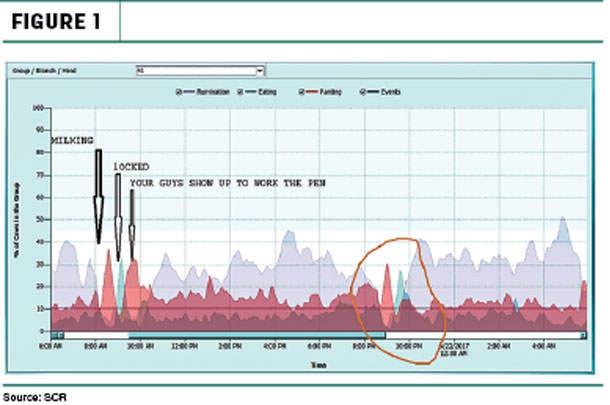Everyone sees the world through their own prism. The same can be said for your cows. The crux of successful dairy management is to make sure the vision of human and animal intersects for a common perception. That is, observing – and managing – your dairy from a cow’s perspective.
Yet, in many cases, daily activities are not necessarily cow-centered because of human interpretation or, more importantly, misinterpretation of cow stress and its effects.
What is viewed as a minor inconvenience by you or your team may have bigger implications for individual cows or groups of cows within your herd. In other words, people may not consider their everyday interactions or “touches” with cows interfere with cows’ desire to be left alone.
This disconnect can lead to cow health and performance challenges. The goal, then, is to tweak perspectives and find solutions that enhance experiences for animals and people.
Protocol influence on a cow’s day
It’s easy to overlook how on-farm actions influence cows, especially since outward appearances can be deceiving. For instance, fresh cow protocols often require all cows in the fresh cow group to be restrained while each one receives a physical exam, even though only a few animals require the extra attention of an exam or resulting intervention.
Depending on group size, these activities can easily take a few hours, which significantly cuts into cow lying and rumination time. Producers often assume since the cows have access to feed during this time, the effects on cows are minimal. After all, the cows appear calm and content.
But when cows spend too much time away from their pen (generally more than 3.5 hours per day), resting time will be reduced. Additionally, these touches alter cows’ routines from day to day, taking them out of their comfort zone – which hinges on an unchanged, predictable schedule.
Lowered lying time comes with a price. It’s estimated you lose 3.7 to 5 pounds of milk per day for each hour of reduced lying time. In turn, management actions influence other activities cows would rather do than spend time waiting on you to complete tasks. The latest research says lactating dairy cows spend about:
- 4.5 hours a day eating (range: 2.4 to 8.5 hours per day)
- Seven hours a day ruminating (range: 2.5 to 10.5 hours per day), with a maximum total chewing time of 16 hours per day
Meanwhile, behavioral data compiled by the William H. Miner Institute shows the top 10 percent of cows rested more than 14 hours a day. Average-ranking cows rested just less than 12 hours per day. Similarly, breeding routines and synchronization protocols can easily become disruptive to cow routines, too.
How many touches?
On many dairies, by the time a healthy cow is confirmed pregnant – if it conceives on the first service – you’ve interrupted the cow’s routine at least 18 times in addition to the general daily activities of feeding and milking.
That figure includes once-daily fresh cow exams for 10 days and the handling required for a PreSynch-Ovsynch breeding protocol, including preg check. It excludes vaccinations, hoof trimming or any interventions if the cow had a health issue.
What effect do these touches have on this cow? Given the number of interactions, its daily routine certainly was anything but dull and repetitive, as the cow prefers.
Figure 1 illustrates the influence of your actions on cows’ rumination patterns during just one event during a protocol.

In this instance, you can see a spike in panting (respiration rate, in red) while the cows are in the holding area, a cooling issue.
When cows are returning to the pen, they are restrained in headlocks. The green spike indicates the percentage of cows eating is going up (green). But once the farm staff arrives to work in that pen, the eating stops, and cow respiration increases. Once cows are released, their panting slows and rumination increases (purple).
At lockup, initial eating time is fairly high but drops sharply as soon as employees begin working the pen. It remains low the rest of the day, finally picking up and remaining consistent following the evening milking and into the night, when no one else is around.
Actionable data
Conversely, what if you only had to touch cows you knew needed a breeding or health intervention? Because of animal monitoring system data accuracy and reliability, users can trust the system to identify cows that require attention – whether a health intervention or for breeding.
Research conducted by Cornell University demonstrated animal monitoring technology accurately identified displaced abomasum as early as three days before cows were identified by highly skilled dairy employees. Further, the rumination monitoring technology identified cases of ketosis about two days prior to physical symptoms and found cases of indigestion nearly a day before physical symptoms appeared.
Therefore, instead of checking every fresh cow every day, your health list includes only those with high probability of a health issue. This instantly reduces touches by 10 for healthy cows. Also, due to highly accurate heat detection, cows on the breeding list only include those requiring insemination. This lowers the number of disruptions to cows not on the list and reduces time for employees to work pens.
One 800-cow herd that’s adopted an animal monitoring system has been able to dramatically reduce healthy cow touches to three or fewer during early lactation – from calving to pregnancy confirmation. The herd maintains a 25 percent pregnancy rate while decreasing treatment and labor costs by more than 45 percent.
On another 1,700-cow dairy, implementing animal monitoring – and trusting the information it provides – saw time in the fresh pen drop from 3.5 hours daily to less than two hours. Additionally, the rumination data allowed them to improve diagnosis success, better note treatment effectiveness and confidently make culling decisions as the situation warranted.
Death loss dropped from 6 to 5 percent, treatment effectiveness improved, and peak milk rose 1 pound per cow for 35 percent of the herd.
For both farms, as well as others across the country, this adjustment has led to substantial savings in time and labor while boosting rumination consistency and enhancing individual cow, group and herd productivity, as well as farm profitability. ![]()
References omitted but are available upon request. Click here to email an editor.

-
Steve Pavelski
- Northeast Sales Manager
- SCR Dairy Inc.
- Email Steve Pavelski






